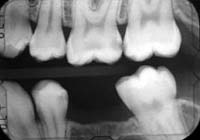An Automatic System for Matching Dental Records

The ADIS must match this pair of x-rays. The teeth match, but the images are flipped [and different how else, if any?]. <br>Credit: Robert M. Howell, DDS
By matching bicuspid to bicuspid and filling to filling, forensic investigators use dental records to give a John or Jane Doe a real name. Researchers from West Virginia University, Michigan State University and the University of Miami are combining advanced image-processing techniques with elements of logic to accelerate and improve the accuracy of identity matches.
The researchers are working on an Automated Dental Identification System (ADIS) that will compare a database of dental x-rays with x-rays of an unidentified victim. Currently, the FBI’s National Crime Information Center uses a text-based database with manually coded descriptions of an individual’s teeth and jaw.
Supported by a National Science Foundation Digital Government award, the team is led by West Virginia University computer science professor Hany Ammar and includes professors Robert Howell at West Virginia, Anil Jain at Michigan State and Mohamed Abdel-Mottaleb at Miami, as well as FBI collaborators in the Criminal Justice Information Services division.
By using x-ray images directly, the system keeps the fine-grained details that are lost when humans do the coding and can spot underlying image structures that are difficult to assess by eye. Still, image-based searching presents new challenges. Most significantly, an x-ray image is affected by the position of the camera with respect to the head, unlike fingerprints inked directly onto a sheet of paper.
“There are ways to standardize the angle at which an x-ray is taken, but they are complicated and not all dentists’ offices would be able to apply them,” said team member Robert Howell, a professor of oral pathology at West Virginia. Central to ADIS is evaluation of the computer science techniques available for aligning images taken at different angles.
In addition, ADIS must apply a certain amount of expert logic. For example, ADIS has to understand, to some degree, which types of restorations—fillings, crowns and the like—could logically have happened since an earlier x-ray and which would be impossible. For example, a missing tooth cannot reappear in a later x-ray, but a broken tooth in an early x-ray could have been repaired or crowned.
From a large database of dental x-rays, ADIS will produce a short list of a few possible matches with a minimum of human intervention. The results will either contain the matching case or correctly return no matches when no match exists, with an error tolerance comparable to that of FBI’s fingerprint matching system. Human investigators will still make the final comparisons against the short match list.
NSF Media Contact: David Hart, 703-292-7737, dhart@nsf.gov
NSF Digitial Government Program: http://www.digitalgovernment.org/
NSF Program Officer: Lawrence Brandt, 703-292-8980, lbrandt@nsf.gov
Principal Investigator: Hany Ammar, 304-293-0405 x2514, hany.ammar@mail.wvu.edu
Robert Howell, 304-293-2671, howell@hsc.wvu.edu
Media Contact
All latest news from the category: Health and Medicine
This subject area encompasses research and studies in the field of human medicine.
Among the wide-ranging list of topics covered here are anesthesiology, anatomy, surgery, human genetics, hygiene and environmental medicine, internal medicine, neurology, pharmacology, physiology, urology and dental medicine.
Newest articles

Properties of new materials for microchips
… can now be measured well. Reseachers of Delft University of Technology demonstrated measuring performance properties of ultrathin silicon membranes. Making ever smaller and more powerful chips requires new ultrathin…

Floating solar’s potential
… to support sustainable development by addressing climate, water, and energy goals holistically. A new study published this week in Nature Energy raises the potential for floating solar photovoltaics (FPV)…

Skyrmions move at record speeds
… a step towards the computing of the future. An international research team led by scientists from the CNRS1 has discovered that the magnetic nanobubbles2 known as skyrmions can be…





















